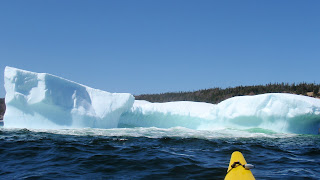 Stan in the foam created by waves crashing on Great Island
Stan in the foam created by waves crashing on Great IslandRight out of the science department - the Theory of love me two times! Really.
OK, so I've borrowed this "Theory" from Jim Morrison. But it does apply to my paddle today. I had two put-ins today, first in Tors Cove to paddle out to Great Island, one of the islands in the Witless Bay Ecological Reserve and a second put-in in Mobile to check out a grounded iceberg.
A group of 10 of us put-in in Tors Cove, Newfoundland to do a paddle out to and around Great Island in the Witless Bay Ecological Reserve, a seabird sanctuary. A swell of 2 - 3 metres with a period of 11 seconds was predicted but with no wind. I don't know about the 11 second thing but we did get up to 3 metres of swell. The swell rebounding off the cliffs made for mildly confused seas but nothing to be concerned with.
After taking out and stowing away or grear and loading the kayaks we headed for home. Stan and I detoured down into the small community of Mobile to check out a grounded berg. What the hell we said, we'll put-in again and go have a look. There'll be more bergs to check out (fingers crossed) but ya never know so we did it while we could.
It was a great paddle today being out with a larger group and I loved both times I got on the water. But I'm not going away, more pictures from today's paddle to post later!
Tony :-)

Derrick and Pam on the seaward side of Great Island. Above Pam's head is throughway in the cliffs but not for today with the 2 - 3 metre swell. Derrick had his "stick" ( OK, Greenland paddle) with him again today and this was the day to test it out at the next level. I'll leave mine home for a while yet until I feel comfortable with it in calm water.

Here's most of the group after rounding Southern Head on Great Island. The swell was predicted to be 2 - 3 metres and we got that but with no wind it was a great day to be out in some bigger water after the calm waters of our winter paddles.

Stopped for lunch on Ship Island (?). There was a bit of talk about all the pictures kayakers take of lunch stops, so, here's mine for this paddle.

Alison and Brian in close to the action on (I think) Ship Island.

Pete was motoring after his lunch of beer and cigarellos!

This was our second stop. Stan with the iceberg grounded in Mobile, Newfoundland.
 Stan on the "grassy knoll" of Ship Island getting his "shot" of our lunch stop
Stan on the "grassy knoll" of Ship Island getting his "shot" of our lunch stop 

















































